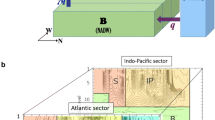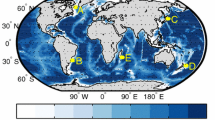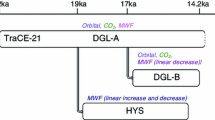Abstract
A close approximation of key state variables and salt fluxes for both the North Atlantic Deep Water (NADW) “on” and “off” states in a General Circulation Model (GCM) is constructed, yielding a natural stability condition. Here, stability is linked to the effect of feedbacks on infinitesimal salinity anomalies on the average Atlantic salinity. The stability condition simply states that the total advective salt feedback must be negative in each steady state, ensuring stability by damping the growth of infinitesimal salinity perturbations. However, a decomposition of the salt feedback into three components shows that only the interaction between the mean salinity and infinitesimal perturbations of the meridional flow have the potential to render a state unstable, holding the key to state transitions. In contrast, the interaction between the mean meridional flow and infinitesimal salinity perturbations yields a negative (stabilising) component feedback. Similarly, the gyre salt flux also stabilises the overturning states. Furthermore, the nodes limiting the “on” and “off” state regimes in the GCM can be accurately computed based on linear fits of basic state variables and the gyre salt flux. It is shown that the NADW “on” state closest to collapse must be contained within a neighbourhood of fresh water exporting states. Finally, the role of temperature in the bistability structure is elucidated.








Similar content being viewed by others
References
Arzel O, England MH, Sijp WP (2008) Reduced stability of the Atlantic meridional overturning circulation due to wind stress feedback during glacial times. J Clim 21:6260–6282
Boris JP, Book DL (1973) Flux-corrected transport. part I: SHASTA: a fluid transport algorithm that works. J Comput Phys 11:38–69
Boyle EA, Keigwin L (1987) North Atlantic thermohaline circulation during the past 20,000 years linked to high-latitude surface temperature. Nature 330:35–40
Broecker WS (1991) The great ocean conveyor belt. Oceanography 4:79–87
Bryan F (1986) High-latitude salinity effects and interhemispheric thermohaline circulations. Nature 323:301–304
Bryan K, Lewis LJ (1979) A water mass model of the world ocean. J Geophys Res 84:2503–2517
DeVries P, Weber SL (2005) The Atlantic fresh water budget as a diagnostic for the existence of a stable shut down of the meridional overturning circulation. Geophys Res Lett 32. doi:10.1029/2004GL021450
Dijkstra HA (2007) Characterization of the multiple equilibria regime in a global ocean model. Tellus 59a:695–705
Dijkstra HA (2008) Scaling of the Atlantic meridional overturning in a global ocean model. Tellus 60a:749–760
Fuerst JJ, Levermann A (2011) Minimal model of a wind- and mixing-driven overturning—threshold behaviour for both driving mechanisms. Clim Dyn 37. doi:10.1007/s00382-011-1003-7
Ganachaud A, Wunsch C (2003) Large scale ocean heat and freshwater transports during the world ocean circulation experiment. J Clim 16:696–705
Gent PR, McWilliams JC (1990) Isopycnal mixing in ocean general circulation models. J Phys Oceanogr 20:150–155
Gerdes R, Köberle C, Willebrand J (1991) The influence of numerical advection schemes on the results of ocean general circulation models. Clim Dyn 5:211–226
Gregory JM, Saenko OA, Weaver AJ (2003) The role of the Atlantic freshwater balance in the hyteresis of the meridional overturning circulation. Clim Dyn 21:707–717. doi:10.1007/s00382-003-0359-8
Griesel A, Morales-Maqueda MA (2006) The relation of meridional pressure gradients to North Atlantic deep water volume transport in an ocean general circulation model. Clim Dyn 26:781–799
Hofmann H, Rahmstorf S (2009) On the stability of the Atlantic meridional overturning circulation. PNAS 106:20584–20589
Hughes TMC, Weaver AJ (1994) Multiple equilibria of an asymmetric two-basin ocean model. J Phys Oceanogr 24:619–637
Huisman SE, den Toom M, Dijkstra HA (2010) An indicator of the multiple equilibria regime of the Atlantic meridional overturning circulation. J Phys Oceanogr 40:551–567
Kalnay E, Kanamitsu M, Kistler R, Collins W, Deaven D, Gandin L, Iredell M, Saha S, White G, Woollen J, Zhu Y, Leetmaa A, Reynolds R (1996) The NCEP/NCAR 40-year re-analysis project. Bull Am Meteor Soc 77:437–471
Levermann A, Fuerst JJ (2010) Atlantic pycnocline theory scrutinized using a coupled climate model. Geophys Res Lett 37. doi:10.1029/2010GL044180
Levermann A, Griesel A (2004) Solution of a model for the oceanic pycnocline depth: scaling of overturning strength and meridional pressure difference. Geophys Res Lett 31. doi:10.1029/2004GL020678
Manabe S, Stouffer RJ (1988) Two stable equilibria of a coupled ocean-atmosphere model. J Clim 1:841–866
Manabe S, Stouffer RJ (1999) Are two modes of thermohaline circulation stable?. Tellus 51A:400–411
Pacanowski R (1995) MOM2 Documentation user’s guide and reference manual: GFDL Ocean Group Technical Report 3, 3rd edn. NOAA, GFDL, Princeton
Rahmstorf S (1996) On the freshwater forcing and transport of the Atlantic thermohaline circultion. Clim Dyn 12:799–811
Rahmstorf S (2002) Ocean circulation and climate during the past 120,000 years. Nature 419:207–214
Rahmstorf S, Willebrand J (1995) The role of temperature feedback in stabilizing the thermohaline circulation. J Phys Oceanogr 25:787–805
Rooth C (1982) Hydrology and ocean circulation. Prog Oceanogr 11:131–149
Saenko OA, Weaver AJ, Gregory JM (2003) On the link between the two modes of the ocean thermohaline circulation and the formation of global-scale water masses. J Clim 16:2797–2801
Sarnthein M, Winn K, Jung SJA, Duplessy JC, Labeyrie L, Erlenkeuser H, Ganssen G (1994) Changes in east Atlantic deepwater circulation over the last 30,000 years: eight time slice reconstructions. Paleoceanography 9:209–267
Sijp WP, England MH (2006) Sensitivity of the Atlantic thermohaline circulation and its stability to basin- scale variations in vertical mixing. J Clim 19:5467–5478
Sijp WP, England MH, Gregory JM (2011a) Precise calculations of the existence of multiple AMOC equilibria in coupled climate models part I: equilibrium states. J Clim (Accepted)
Sijp WP, Gregory JM, Tailleux R, Spence P (2011b) The key role of the western boundary in linking the amoc strength to the north-south pressure gradient. J Phys Oceanogr (In Revision)
Smith RS, Gregory JM, Osprey A (2008) A description of the famous (version xdbua) climate model and control run. Geosci Model Dev 1:53–68
Stommel H (1961) Thermohaline convection with two stable regimes of flow. Tellus 13:224–230
Talley LD (2008) Freshwater transport estimates and the global overturning circulation: Shallow, deep and throughflow components. Prog Oceanogr 78:257–303
Thorpe RB, Gregory JM, Johns TC, Wood RA, Mitchell JFB (2001) Mechanisms determining the Atlantic thermohaline circulation response to greenhouse gas forcing in a non-flux-adjusted coupled climate model. J Clim 14:3102–3116
Vellinga M, Wood RA (2002) Global climatic impacts of a collapse of the Atlantic thermohaline circulation. Clim Change 54:251–267
Weaver AJ, Eby M, Wiebe EC, co authors (2001) The UVic Earth System Climate Model: model description, climatology, and applications to past, present and future climates. Atmosphere-Ocean 39:1067–1109
Zalesak ST (1979) Fully multidimensional flux-corrected transport algorithms for fluids. J Comput Phys 31:335–362
Acknowledgments
We thank the University of Victoria staff for support in usage of the their coupled climate model. This research was supported by the Australian Research Council and the Australian Antarctic Science Program. This research was undertaken on the NCI National Facility in Canberra, Australia, which is supported by the Australian Commonwealth Government. We thank Jonathan M. Gregory for hosting several visits to the University of Reading, UK, and many stimulating discussions.
Author information
Authors and Affiliations
Corresponding author
Appendix: Linear relationships
Appendix: Linear relationships
Local salinities, such as that of the North Atlantic, are assumed to be linearly related to the average Atlantic salinity in the hysteresis parameter experiment. Here, a simplified theoretical argument is offered to suggest that this is plausible. Consider the Atlantic divided into two meridionally adjacent boxes of the depth of the overturning and each spanning the entire basin width, and having a volume V i . Denote the combined volume of the Atlantic boxes by V. One could represent the subtropical Atlantic, and the other the high northern latitudes. Let the southern box have salinity S 2 and surface flux F s,2, while the northern box has salinity S 1 and surface flux F s,1. Also assume a constant salinity S 3 for the Southern Ocean, which is in contact with the southern box. There is no further northward exchange from the northern box. Assume an anomalous flux H is applied to F s , consisting of component fluxes over each box i of H i = c i H for constants c i (that is, the anomalous flux over each box is proportional to the total flux). Denote the change in S i associated to H i (compared to H = 0) by δS i .
First, assume only a simple diffusive exchange with coefficients r i between the boxes i and i + 1 (mimicking the gyres). Then the exchange between the SO box and the southern box in the Atlantic is r 2(S 3 − S 2) and r 1(S 2 − S 1) between box 2 and 1. Flux balance with surface fluxes and re-arrangement of the terms gives: \(S_{1} = S_{2} + r_{1}^{-1}F_{s,1}\) and \(S_{2} = S_{3} + r_{2}^{-1}F_{s}. \) Therefore, \(\delta S_{1} = r_{1}^{-1}c_{1}H + \delta S_{2}\) and \(\delta S_{2} = r_{2}^{-1}H\) as S 3 is constant. Also, \(\delta \bar{S} = V^{-1}(V_{1}\delta S_{1} + V_{2}\delta S_{2} ) = (\frac{V_{1}}{V} r_{1}^{-1} c_{1} +r_{2}^{-1} )H\) As a result, \(\frac{\delta S_{i}}{\bar{S}}\) are constant and the relationships between S i and \(\bar{S}\) is linear. This process can be generalised to more boxes. In conclusion, the linearities between local salinities and the basin-wide average salinity is easy to show for a simple diffusive box model.
We now incorporate the zeroth order effect of the AMOC, and estimate the error in the coefficients arising from this approximation. Let the gyre transport from the southern box to the northern box be γ G(S 2 − S 1), where G is the gyre volume transport and γ some constant incorporating basin width, depth and other factors. Similar, considering the choice of box depth, let the MOC transport be γ M(S 2 − S 1). Then S 1 can be expressed as S 1 = S 2 + γ−1(α + M)−1 F s,1. Taylor expansion of the second term on the right in terms of a perturbation M = M 0 + δM around some average M 0 yields
Using a gyre strength G = 40 Sv, overturning M 0 = 10 Sv and perturbation δM = 5 Sv, an estimate of the first order term (second term) yields 10% of the zeroth order term (first), while the the second order term (third term) is 1%. We accept the 10% error and use a zeroth order approximation, yielding:
Renaming the coefficient r 1 ≡ γ(α + M 0) and r 2 ≡ γ′(α′ + M 0) , where γ′ and α′ are the equivalent parameters to γ and α but appropriate to the interface between the Southern Ocean and the southern box in the Atlantic, we recognise the diffusive model described above, where the linearities hold. We saw that we can expect a 10% error in the terms \(r_{i}^{-1}. \) In practice, this leads to a smaller error in the quotient \(\frac{S_{1}}{\bar{S}}, \) as the r i terms can be divided out if r 1 ≈ r 2 . Note that the reverse circulation of the OFF state should yield a smaller error, as δM is smaller. In summary, it is reasonable to expect the linear relationships between local salinity of a box and the basin-wide average salinity under changes in the control parameter H in a gyre-dominated case (assuming unchanging gyres), and deviations from this linearity due to the AMOC may be small. Note that this is contrary to the speculation about the ON state stated in Sijp et al. (2011a).
Rights and permissions
About this article
Cite this article
Sijp, W.P. Characterising meridional overturning bistability using a minimal set of state variables. Clim Dyn 39, 2127–2142 (2012). https://doi.org/10.1007/s00382-011-1249-0
Received:
Accepted:
Published:
Issue Date:
DOI: https://doi.org/10.1007/s00382-011-1249-0
Keywords
- AMOC
- Atlantic
- Atlantic meridional overturning circulation
- Bistability
- Non-linear system
- Climate change
- NADW formation
- NADW shutdown
- Gulf stream shutdown
- North Atlantic deep water
- Deep sinking
- Convection shutdown
- Poleward heat transport
- Halocline catastrophe
- Box model
- Two stable states
- Critical points
- Non-linear theory
- Saddle nodes
- Limit point




